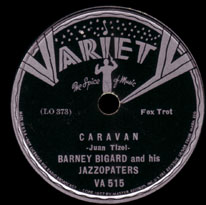
Edward Kennedy "Duke" Ellington was an American jazz pianist, composer, and leader of his eponymous jazz orchestra from 1923 through the rest of his life.

Albany Leon "Barney" Bigard was an American jazz clarinetist known for his 15-year tenure with Duke Ellington. He also played tenor saxophone.

Clark Virgil Terry Jr. was an American swing and bebop trumpeter, a pioneer of the flugelhorn in jazz, and a composer and educator.
James Wesley "Bubber" Miley was an American early jazz trumpet and cornet player, specializing in the use of the plunger mute.

Charles Melvin "Cootie" Williams was an American jazz, jump blues, and rhythm and blues trumpeter.

Thaddeus Joseph Jones was an American jazz trumpeter, composer and bandleader who has been called "one of the all-time greatest jazz trumpet soloists".

Wallace Roney was an American jazz trumpeter. He has won 1 Grammy award and has two nominations.

William Alonzo "Cat" Anderson was an American jazz trumpeter known for his long period as a member of Duke Ellington's orchestra and for his wide range, especially his ability to play in the altissimo register.

"Caravan" is an American jazz standard that was composed by Juan Tizol and Duke Ellington and first performed by Ellington in 1936. Irving Mills wrote lyrics, but they are rarely sung.
"Diminuendo and Crescendo in Blue" is a jazz composition written in 1937 by Duke Ellington and recorded for the first time on May 15, 1937 by the Duke Ellington Orchestra with Wallace Jones, Cootie Williams (trumpet), Rex Stewart (cornet), Barney Bigard (clarinet), Johnny Hodges, Otto Hardwick, Laurence Brown, Joe Nanton (trombone), Harry Carney, Sonny Greer (drums), Wellmann Braud (bass), Freddie Guy (guitar), and Duke Ellington (piano). No tenor saxophone was present in this recording section, nor in "Crescendo in Blue," which was recorded the same day. In its early form, the two individual pieces, "Diminuendo in Blue" and "Crescendo in Blue," were recorded on opposite sides of a 78 rpm record. The 1956 performance at the Newport Jazz Festival revitalized Ellington's career, making newspaper headlines when seated audience members chaotically began rising to dance and stand on their chairs during Paul Gonsalves's tenor saxophone solo.

Gerald Stanley Wilson was an American jazz trumpeter, big band bandleader, composer, arranger, and educator. Born in Mississippi, he was based in Los Angeles from the early 1940s. He arranged music for Duke Ellington, Sarah Vaughan, Ray Charles, Julie London, Dizzy Gillespie, Ella Fitzgerald, Benny Carter, Lionel Hampton, Billie Holiday, Dinah Washington, and Nancy Wilson.
Orchestral jazz or symphonic jazz is a form of jazz that developed in New York City in the 1920s. Early innovators of the genre, such as Fletcher Henderson and Duke Ellington, include some of the most highly regarded musicians, composers, and arrangers in all of jazz history. The fusion of jazz's rhythmic and instrumental characteristics with the scale and structure of an orchestra, made orchestral jazz distinct from the musical genres that preceded its emergence. Its development contributed both to the popularization of jazz, as well as the critical legitimization of jazz as an art form.
Arthur Parker Whetsel was an early "sweet" trumpeter for Duke Ellington's Washingtonians.
"Day Dream" is a jazz standard composed by Billy Strayhorn with lyrics by John Latouche and written in 1939. It was first recorded by saxophonist Johnny Hodges and his ensemble on November 2, 1940. Duke Ellington was credited as co-composer on the label of the original 78 RPM release, though he is not generally considered to be one of the song's creators.
Richard Gene Williams was an American jazz trumpeter.
Fred Stone was a Canadian flugelhornist, trumpeter, pianist, composer, writer, and music educator. He worked as a soloist within both the classical and jazz repertoires from the 1950s through the early 1970s, appearing in concerts with the Duke Ellington Orchestra, the Toronto Symphony Orchestra, the Winnipeg Symphony Orchestra, the Detroit Symphony Orchestra, the Cleveland Orchestra, the Buffalo Philharmonic Orchestra, the Ottawa Symphony Orchestra, and the San Diego Symphony. Between 1971 and 1983, he mainly focused on his work as a composer and teacher, making only periodic public performances, and often with ensembles composed largely of his students. In 1984, he formed "Freddie's Band", a jazz ensemble in residence at The Music Gallery in Toronto. He performed with this group up until his death two years later.

The Carnegie Hall Concerts: January 1943 is a live album by American pianist, composer and bandleader Duke Ellington recorded at Carnegie Hall, in New York City in 1943 and released on the Prestige label in 1977.
William Richard Berry was an American jazz trumpeter, best known for playing with the Duke Ellington Orchestra in the early-1960s, and for leading his own big band.
Irvin Stokes is an American jazz trumpeter.
Melton "Shakir" Mustafa Sr. (November 23, 1947 – December 28, 2017) was an American jazz musician, music educator, and arranger who played the trumpet and flugelhorn.










